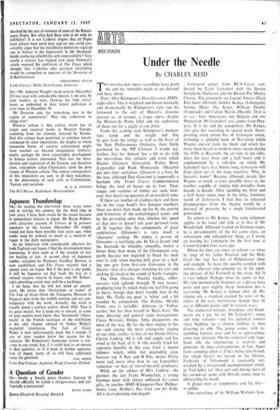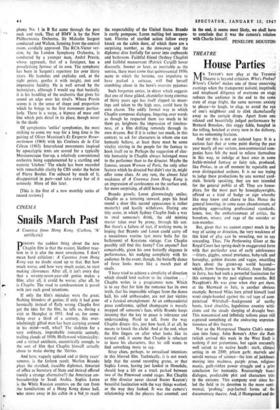Under the Needle
RECORDS
By CHARLES REID
wo massive new opera recordings have given me and my turntable much to get devoted and busy about.
First : Otto Klemperer's Don Giovanni (HMV, eight sides). This is weighted and driven musically and dramatically by Klemperer's view (see his foreword to the set) of Mozart's dramma giocoso as, in essence, a tragic opera, despite the Mozart/da Ponte label and the sophistries of those out for a giggle at any price.
From this reading stem Klemperer's momen- tous tempi and the weight and bite he gets from the strings as well as the brass of the New Philharmonia Orchestra (here finely partnered by the NP Chorus). I would say, further, that his 'demon' has a lot to do with the marvellous fire, velocity and truth which Nicolai Ghiaurov (Giovanni), Walter Berry (Leporello) and Paoli Montarsolo (Masetto) put into their recitatives. Ghiaurov is a bass, by the way, although Don Giovanni is supposedly a baritone role. Franz Crass's Commendatore brings the total of basses up to four. Their ranges and varieties of timbre are such, how- ever, that there's no question of an overdark tone.
If there are touches of staidness here and there (as in the stage band's first banquet number), these are more than made up for by the gravity and brimstone of the eschatological scenes and by the pervading sense that, whether this speed or that suits or doesn't suit your personal taste, all fit together like the components of great architecture. Ghiaurov's is very much a 'character' reading. He makes a person of Giovanni—a terrifying one. In 'La ci darem' and the Serenade he wheedles smoothly, makes a better thing than many of the Champagne aria, partly because not required to break his neck over it, and, when nearing hell, gives us a feel- ing one gets from first-rate Giovannis in the theatre—that of a charger twitching his ears and shaking his head at the sound of battle trumpets.
The Don Ottavio, Nicolai Gedda, roller- coasters with aplomb through 11 mio tesoro,' producing long Fs which make me feel I'm going to burst, though they don't trouble him in the least. His Dalla sua pace' is 'white' and a bit wooden by comparison. The Zerlina, Mirella Freni, too, is variable: delicious in 'Vedrai, carino,' but less than herself in `Batti, batti.' On tone, phrasing and general voice management, Claire Watson's Donna Anna disappoints me most of the way. By far the best singing in this set—and among the most aristocratic singing of our time, surely—is that of the Donna Elvira, Christa Ludwig. All is silk and supple and has mind at the back of it. A retle usually listed for sopranos benefits in this case from a mezzo richness which, while not precluding easy, lustrous top A flats and B flats, makes Elvira more real, more alive than in, say Leporello's valuation—or that of run-of-the-mill producers.
While on the subject of Miss Ludwig: she partners the late Franz Wunderlich, a young German tenor with almost unflawed bel canto gifts, in another HMV-Klemperer-New Philhar- monia issue, Mahler's Das Lied von der Erde. All is heart-piercing and elegant Lohengrin comes from RCA-Victor, con- ducted by Erich Leinsdorf with the Boston
Symphony Orchestra and the Boston Pro Musica Chorus. The principals are Lucine Amara (Elsa), Rita Gorr (Ortrud), Sandor Konya (Lohengrin), Jerome Hines (the King), William Dooley (Frederick) and Calvin Marsh (Herald). That is to say : four Americans, one Belgian and one Hungarian. Mr Leinsdorf, too, comes from Hun- gary. It is he and his compatriot, Mr Konya, who give this recording its special mark. Incor-
porating every extant bar of Lohengrin music, including a splendid hunk of Narration which Wagner excised from the finale and which has never been heard in modern times except during the 1930s at Bayreuth, the set runs to ten sides, plays for over three and a half hours and is supplemented by a talk-disc on which Mr Leinsdorf fears that, before long, Lohengrin will drop clean out of the stage repertory. Why, in heaven's name? Because although people like Wagner as much as ever, possibly more so, the number capable of singing him dwindles from decade to decade. After spending my three and a half hours twice over in the lofty, luminous world of Lohengrin, I feel that its tolerated disappearance from the theatre would be a betrayal of posterity by a single fainthearted generation.
To return to Mr Konya. The same judgment applies to his voice and style as to that of Mr Wunderlich. Although trained on German stages, he is pre-eminently of the bel canto class, an unforeseen and unhoped-for thing, as I wrote on hearing his Lohengrin for the first time at Covent Garden four years ago.
Where his lines are tense or valiant—as when he sings of his father Parzival and the Holy Grail—his lop' has lots of Heldentenor shine and strength. To have this quality coupled with remote, ethereal tone-spinning (as in the open- ing phrases of his Farewell to the swan, Act 1) is rare indeed. Perhaps twice he seems to tire. His tone momentarily blanches, or a phrase loses poise and goes slightly sharp. Somehow this is reassuring. Mr Konya is human after all. His singing sets a standard reached by none of the others in the cast, meritorious though they all are at different points and in various ways.
The orchestral torrents, broodings and bland- ncsses are a joy. So are Mr Leinsdorf's tempi and tone volumes—and his technical control when building up a climax, holding it, then directing its ebb. The pomp scenes, with re- sponding fanfares near and far or approaching, come over elatingly. On the orchestral and stage- hand side the engineering is realistic and generous. At times over-generous, in fact. Apart from sounding often as if he's being echo-boxed, for which there's no reason in the libretto, Frederick of Telramund is constantly out- weighed by a foreground accompaniment which, in `Viel lieber tot' (first act) and during most of his second-act scene with Ortrud, comes near to obliterating his words.
A glance now at symphonies and the like— or unlike.
Two recordings of Sir William Walton's Sym-
phony No. I in B fiat came through the post neck and neck. That of HMV is by. the New Philharmonia Orchestra. Sir Malcolm Sargent conducted and Walton, listening from the control room, cordially approved. The RCA-Victor ver- sion, by the London Symphony Orchestra, is conducted by a younger man, Andri Previn, whose approach, that of a foreigner, has a proselytising fervour of its own. The symphony has been in Sargent's repertory for over thirty years. He launches and explodes and, at the right points, gentles it with insight, zest and impressive lucidity. He is well served by the technicians, although I would say that basically it is his handling of the orchestra that gives his sound an edge over his rival's. Where Previn scores is in the sense of shape and proportion which he brings to the first movement particu- larly. There is a surge, a bigness of mass and line which puts detail in its place, though never in the shade.
Of symphonies 'unlike' symphonies, the most striking to come my way for a long time is the pairing of Oliver Massiaen's Et Exspecto Resur- rectionem (1964) with his Couleurs de la Cite Celeste (1963). Interrelated movements inspired by apocalyptic texts are scored for a typically Messiaenesque line-up, a relatively conventional orchestra being supplemented by a startling and esoteric 'kitchen.' The whole has been recorded with remarkable clarity by CBS under the baton of Pierre Boulez. I'm seduced by much of it, disappointed in part—and take every bar of it seriously. More of this later.
[This is the first of a new monthly series of record reviews.]































 Previous page
Previous page